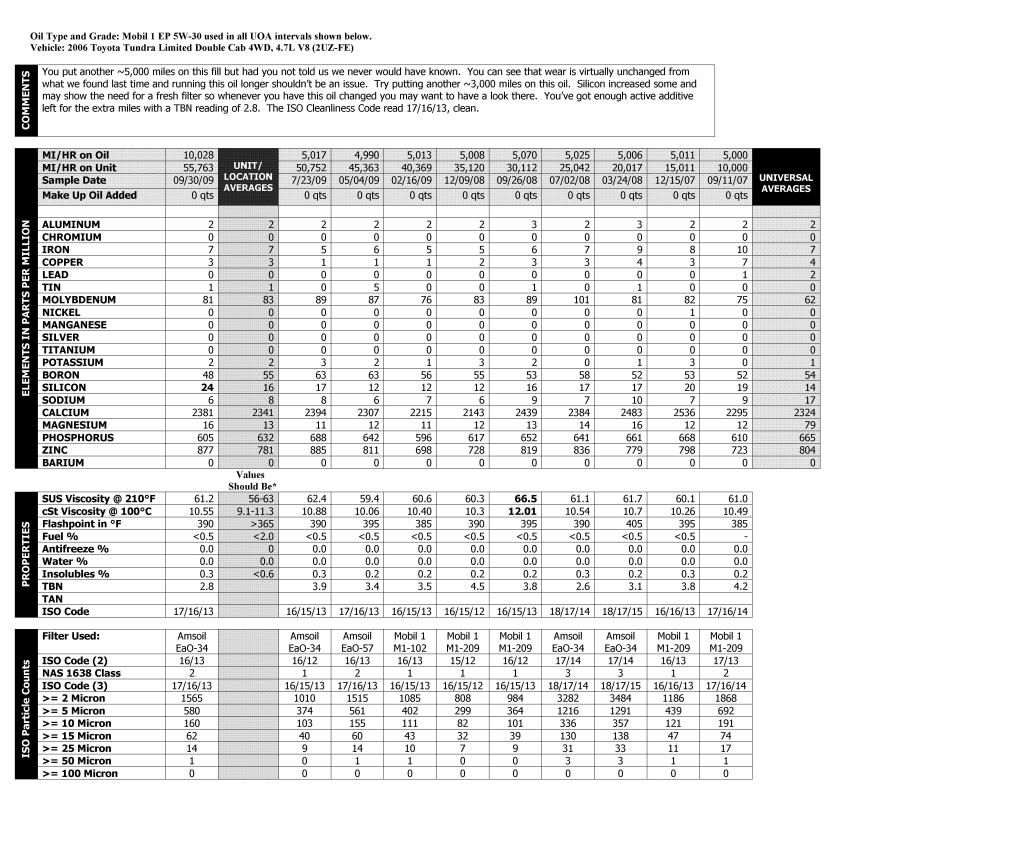Hello everyone,
Here is UOA Number 10, with particle counts and TBN. Note that this UOA is the same "batch" of oil, as well as the same oil filter, as was reported on July 23, 2009, only now, I have taken that oil/filter combination out to 10K miles. Here are my comments - I welcome yours as well.
1) Clearly we see an example here of how non-linear the decrease in TBN is. The first UOA on this batch of oil had 5,017 miles on it. This UOA added another 5,011 to this oil, almost exactly double the amount, yet the TBN went down only slightly more than one point.
2) Interesting how the wear metals increased only slightly, not double the level of before. Looks like Iron and Copper are the two primary wear metals here.
3) Not sure what to make of the significant increase in Silicon. The first air filter I changed on this vehicle was at about 35K miles, and it looked like it could easily have gone further - it wasn't that dirty. So far, this one only has about 20K on it so it shouldn't need changing yet. I don't want to open the air filter box while I am in the middle of an interval - My theory is doing so may release some bits of sand/grit which could affect the results.
4) So much for the theory that the oil filter should get more efficient in filtering as it gets older - the oil is clearly dirtier than the July UOA, although I am happy to see total solids stayed the same at 0.3.
I installed a Mobil 1 M1-209 filter, and a fresh batch of Mobil 1 EP 5W-30, and again plan to take samples at both 5K and 10K miles - we'll see how the Mobil 1 filter does out to 10K miles.

Here is UOA Number 10, with particle counts and TBN. Note that this UOA is the same "batch" of oil, as well as the same oil filter, as was reported on July 23, 2009, only now, I have taken that oil/filter combination out to 10K miles. Here are my comments - I welcome yours as well.
1) Clearly we see an example here of how non-linear the decrease in TBN is. The first UOA on this batch of oil had 5,017 miles on it. This UOA added another 5,011 to this oil, almost exactly double the amount, yet the TBN went down only slightly more than one point.
2) Interesting how the wear metals increased only slightly, not double the level of before. Looks like Iron and Copper are the two primary wear metals here.
3) Not sure what to make of the significant increase in Silicon. The first air filter I changed on this vehicle was at about 35K miles, and it looked like it could easily have gone further - it wasn't that dirty. So far, this one only has about 20K on it so it shouldn't need changing yet. I don't want to open the air filter box while I am in the middle of an interval - My theory is doing so may release some bits of sand/grit which could affect the results.
4) So much for the theory that the oil filter should get more efficient in filtering as it gets older - the oil is clearly dirtier than the July UOA, although I am happy to see total solids stayed the same at 0.3.
I installed a Mobil 1 M1-209 filter, and a fresh batch of Mobil 1 EP 5W-30, and again plan to take samples at both 5K and 10K miles - we'll see how the Mobil 1 filter does out to 10K miles.

